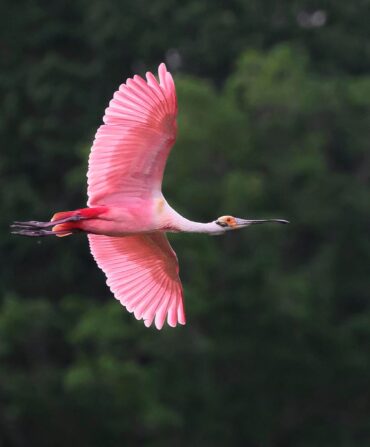Back-to-school time brought new beginnings for me: I became an assistant professor of English at Augusta University in Georgia. In the middle of August, I found myself amid a crush of eager students toting newly purchased books and searching for classrooms.

After ten years of bouncing around the country teaching wherever folks would let me, finding employment in my home region and teaching invigorating classes felt like a gift. But my ears were unprepared for the transition from wandering the woods and writing in isolation to the chaos of college. There was always a door opening or closing somewhere. I could hear my colleague clearing his throat through the wall. The air handler in the ceiling thrummed nonstop above my writing desk. Students clopped down the hall in their boots, talking, squeaking, yelling at one another as youth often do. Every day I sat in my office struggling to focus, sonically overwhelmed by the man-made cacophony.
Years ago, I had heard about Gordon Hempton, one of the cofounders of Quiet Parks International, a nonprofit “committed to saving quiet for the benefit of all life,” and an Emmy-winning acoustic ecologist based in the Pacific Northwest. Hempton has traveled the world for more than three decades pursuing Earth’s rarest sounds, emphasizing remote locations and disappearing soundscapes, like the calls of the last mated pair of northern spotted owls in a Washington State county.
I give him a call and tell him about how discombobulated I feel. Is there anywhere left in the rapidly developing South where I could find reprieve? Joyce Kilmer Memorial Forest, he says, just east of the Tennessee border in Robbinsville, North Carolina, one of twelve locations in the United States where he has measured a lack of man-made noise for at least fifteen minutes. He recommends I visit on a Sunday in early autumn, when the leaves are turning and the winter wren will be singing. “Go at dawn—that’s when the world will be quiet,” he says.
Hempton then leads me through an exercise he often does to recenter himself. I close my eyes. “Sounds travel around corners, and through objects,” he intones. “There’s none of the restrictions of our eyes. It’s not one direction. We can’t even close our ears like we close our eyes.” He continues: “For the next few moments, your ears are going to be your musical instruments. We have to tune ourselves before we get deeper into listening.” After a few deep breaths, he asks, “What is the furthest sound you can hear? Don’t tell me. Just listen for it.”
My living room is quiet, but I can hear Luna, my Portuguese water dog, slumbering at the end of the hallway, her collar clinking as she breathes. Hempton reminds me to relax. “The ears have some of the smallest bones and muscles in the whole body, and just a little bit of tension will actually affect what you can physically hear.”
I let my jaw go slack and I’m able to listen further. Out on the street, a delivery person closes the door of an idling truck.
“When we give it enough time, we finally reach our auditory horizon,” Hempton explains, which measures your area of awareness. “In a place free of noise pollution, like the Kalahari Desert, the auditory horizon is more than twenty miles.” In the last century or so, our world with its planes, trains, automobiles, and rockets has become as loud as it’s ever been, and that horizon has shrunk. The din can affect health and well-being—studies have linked noise pollution to hearing impairment, hypertension and heart disease, sleep disturbance, and diminished cognition and learning capacity.
Hempton’s last piece of advice: “If you’re going to truly listen, you might actually hear something that profoundly changes you, that you have never heard before or didn’t hear that way before. You have to be willing to become changed by what you hear.” I wonder, though, if what I’m searching for has already vanished; Hempton claims there isn’t a place in the world noise pollution hasn’t touched.
Later that month, I head to Joyce Kilmer Memorial Forest, 3,800 acres of old-growth hardwoods in Graham County, North Carolina, set aside in 1936 as a tribute to the poet Joyce Kilmer. Known chiefly for “Trees,” the famous twelve-line verse published in 1913 that begins, “I think that I shall never see / A poem lovely as a tree,” Kilmer died in action during World War I. In 1975, the forest became part of the larger Joyce Kilmer–Slickrock Wilderness Area, covering an additional 13,000-plus acres.
I leave my hotel at 3:15 to travel through the early morning fog up the winding road that leads to the trailhead. Here, I shut my car off, listening to each of the elements power down. With no cell service and only my red-light headlamp to guide me, I lumber into the dark, I and some unidentifiable insects the only noisemakers. As my eyes adjust, my surroundings emerge from the pitch black: the deep violet of the night sky, the dark navy of slick boulders, the charcoal outline of the tree roots I trip over, their onyx leaves in the canopy above.
For three miles, I feel my way through the shadows, ferns tickling my knees and absorbing my shuffles, until I reach a giant poplar grove where Kilmer’s memorial plaque lies. I turn off my light, fold myself up on the rock embedded with the plaque, and try to become part of the scenery as I listen. I hear nothing but the plink and plop of light rain on leaves, the occasional rustle of wind between the trees. A little farther off, the whir and whish of Little Santeetlah Creek arise as the four-hundred-year-old poplars groan. The longer I sit, the more the forest seems to breathe—here, I realize, quiet isn’t the absence of anything, but the presence of everything.
Dawn comes, and with it, the seesaw birdsong of the black-and-white warbler, the high-pitched pik of the downy woodpecker. When it’s light enough, I leave the grove and spend the rest of the morning wandering through millions of years of geology, studying the topography, marveling at slate and metasiltstone, taking in the sycamores, basswoods, and oaks. Jewelweed and goldenrod surround me; the last of the fire pinks cling to the side of an outcrop, their intense red flowers popping in the shade. Among rhododendrons so deep in the understory they will never bloom, I hear it: the muffled whoosh whoosh of an airplane. Five minutes later I hear the boom and throops of a different aircraft and see it streaking through the sky, now light blue. They come again—7:31, 7:44, 7:48, 7:58. The spell is broken.
I make my way to Maple Springs Overlook, which sits at the end of a five-mile “road to nowhere.” The wooden platform at the top of the mountain looks out over the terrain, to Cheoah Lake. I eat my breakfast, still listening.
A dog, down in the valley, barks incessantly—miles off, at the base of a different mountain. On the ridge below me, a branch snaps. My skin prickles, and my imagination goes on a tear—a raccoon? Perhaps a bear? I hear the hum of a motorcycle growling its way up the road behind me. Another plane buzzes overhead. I keep count—there is never more than forty seconds of silence at a time. At 8:53 a motor revs. I wonder what this encroaching noise means for the animals around me—if the owl can still hear the mouse skittering in the leaves, if the deer can still sense the bobcat stalking it.
By the time I get back home, my world has filled with noise again. But now, thanks to Hempton’s exercise helping me feel a modicum of control among all this change, I find something to relish: the sounds of silence in between.








